
This week for Flora and Fauna Friday, I’m presenting an introduction to animal tracks.
The winter can be boring for a naturalist, especially if stalking ducks or chasing shorebirds isn’t your cup of tea. As trees lose their leaves, annuals dry up, perennials die back to their roots, reptiles and amphibians hibernate, and the birds quiet down, it becomes much harder for naturalists to find wildlife in the winter months. However, winter is an opportune time to look for animal tracks. As plants stop growing for the winter and take in much less water from the soil, leaving the ground soft and soggy. Annuals die off for the year, exposing bare soil. Mammals have to search more to find food, so they travel further than normal and farther from the beaten path. Most mammals are nocturnal, so the longer nights give them more time to forage. If it snows, that just means an animal will leave tracks everywhere it goes. All these factors improve both the quality and quantity of animal tracks found in the winter and create a perfect environment for a naturalist to see just how many and what types of mammals surround them throughout the year.
Below I have a sample of most of the common species you’ll find tracks for on Edisto. Try and see how many you can identify! I have the species and track characteristics for each photo in the descriptions.
What exactly is an animal “Track”?
Tracks are the physical impressions an animal makes in the substrate, the material the ground is made of, as it moves through its environment. Tracks are predominantly footprints but, for example, also include things like tails drags for Alligators. Tracks are not to be confused with “Signs”, which are any other environmental indication of an animal’s presence. Signs include things like: trails, scat, slides, burrows, holes, rubs, scrapes, chew marks, etc. Signs are equally useful in identification but, with the exception of droppings, signs are typically found under unique circumstances and in specific locations. Since most signs are subtle in nature and unique for certain types of animals, I’ll just be talking about tracks today.
Now, where can one find tracks?
In my experience dirt roads, marsh flats, nature trails, point bars, and the banks of ocean inlets are the best places to find tracks. However, any place with lots of bare earth and soft soil is a good bet. If you follow Deer and Raccoon trails, which many other species use, sooner or later you’ll find a depression or patch of dirt where tracks are present.
What species can you expect to find tracks for?
That all depends on the type of substrate you’re dealing with and the habitat you’re in. If you’re dealing with dew dampened sand on an island driveway, it’ll hold tracks for everything between a Horse and a Dung Beetle. However, dry, hard-packed clay on a causeway may not even take deer tracks unless there was a torrential rain the day beforehand. For the most part, you’ll only see tracks for animals the size of a Squirrel or larger. As far as habitats go, typically you see more tracks where animals tend to gather. The edges of wetlands, marshes, and fields act as natural borders that mammals follow. Open areas on causeways and dikes act as bridges for Mink, Raccoons, Otters, Alligators, and Turtles to pass between wetlands. Carnivores like to hunt on the edges of heavy brush where Deer, Rabbits, and Turkeys retreat during the day. Birdfeeders attract Squirrels, Rats, Raccoons, and Deer looking for an easy meal. After them may come predators like Bobcats, Coyotes, Foxes, or Mink. Armadillos and Opossums may show up as well to eat invertebrates in the feeder spill or by following an established trail. Mammals are by far the most common and easiest to identify tracks. Turkeys and Alligators are also quite common and easy to distinguish. You can expect to find Raccoon, Deer, and Armadillo tracks anywhere you look.
How do you identify tracks?
Identifying tracks successfully requires having a good understanding of the body shape, behavior, and lifestyle of the animals that make them. Some species, like the Nine-banded Armadillo and Virginia Opossum, leave tracks so distinct they can’t be mistaken for anything else. Others, like Bobcats and Feral Cats or Coyotes and Hound Dogs, require a good deal of investigation to tell apart. The important features to look at in tracks are size, depth, gait, and the shape and arrangement of the individual parts of the foot that left impressions. The size of the track tells you exactly how big the foot of the animal that made it was. This is very important in telling Canids apart. Depth gives you an estimate of how heavy the animal was and the force with which the animal landed. Gait tells you the length of the animal’s stride and whether it was walking, trotting, or sprinting. The shape and arrangement of the track itself is the most important feature in identification. The shape and location of the heel, toes, and nails is unique for almost every mammal species in our area. I get into the specifics for each species in the descriptions of the photos below.
Now get out there are see who’s been hanging out in your backyard when you weren’t looking!
PHOTO DESCRIPTIONS

1. American Mink
The tracks of the American Mink are consistently circular in appearance with five toe pads and claw marks. They are almost always found near wetlands.
The Mink is one of our more confusing track makers. All the tracks in this photo are from a Mink. The Mink is a highly agile animal that has quite chaotic movements. This necessitates that they vary the shape of their feet to provide the best traction possible for their current gait and the surface they’re moving on. This results in highly variable tracks, with a hard to decipher gait, that crisscrosses over top of itself. The Mink’s tracks are most easily confused with those of the Common Raccoon, as well as the Bobcat and North American River Otter. Otter Tracks are very similar in shape but are far larger, about the size of your palm. The walking tracks of the Mink look a lot like a Bobcats but Mink have a fifth toe, consistent claw marks, and a larger foot. Raccoons are the most similar in size but their hand-like feet leave prints with elongated toes that are strongly connected to the heel and claw marks that blend into the tip of the toes. Raccoon Tracks are typically more triangular in shape than circular.
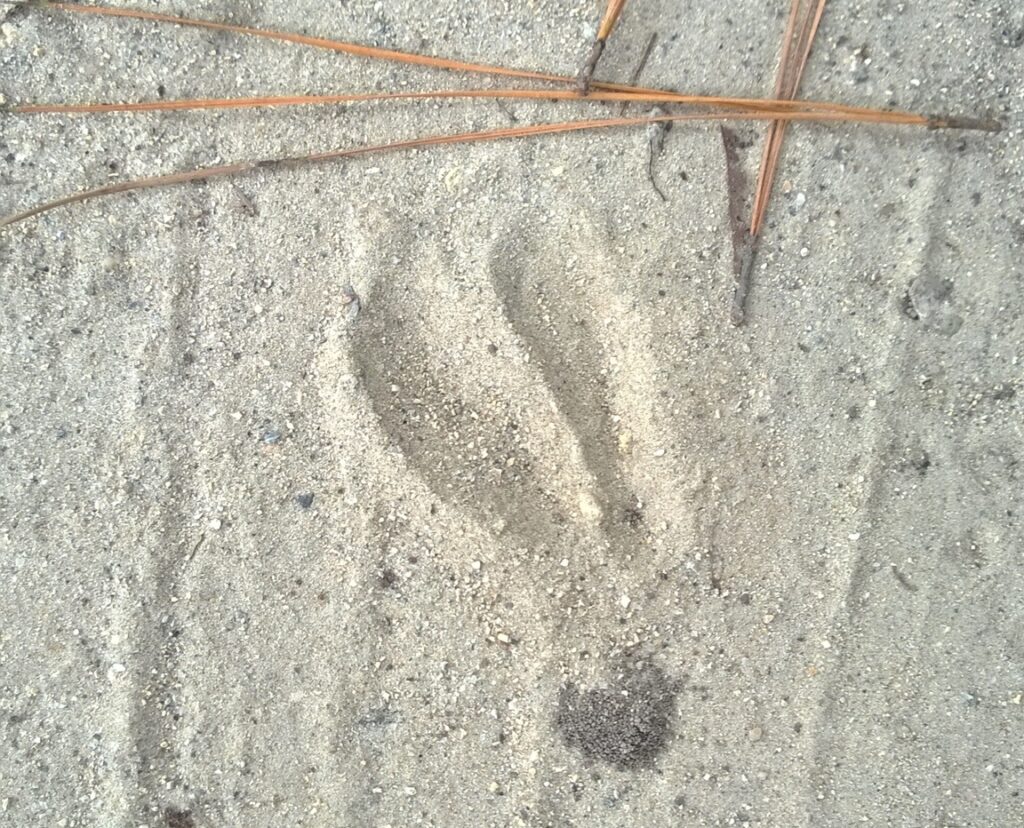
2. White-tailed Deer
The Tracks of the White-tailed Deer, along with the Common Raccoon, are the most common tracks you’ll encounter in the Lowcountry. Deer tracks consist of two tapered, mirrored hoof prints and occasionally an additional set of tiny rear hoof marks, especially from mature bucks. Deer heavily utilize trails and are fond of walking along dirt roads. So if you follow one long enough, you’re bound to find some tracks.
Excluding livestock, there’s only one other species that has tracks resembling the White-tailed Deer, the Feral Hog. The hooves of Feral Hogs are not tapered like those of Deer, so they leave a set of mirrored semi-circles. This gives the prints of a Deer a heart or crab-claw shape and the Feral Hog that of a rounded rectangle. The rear hoof prints of a Hog are also typically larger and farther to the outside.
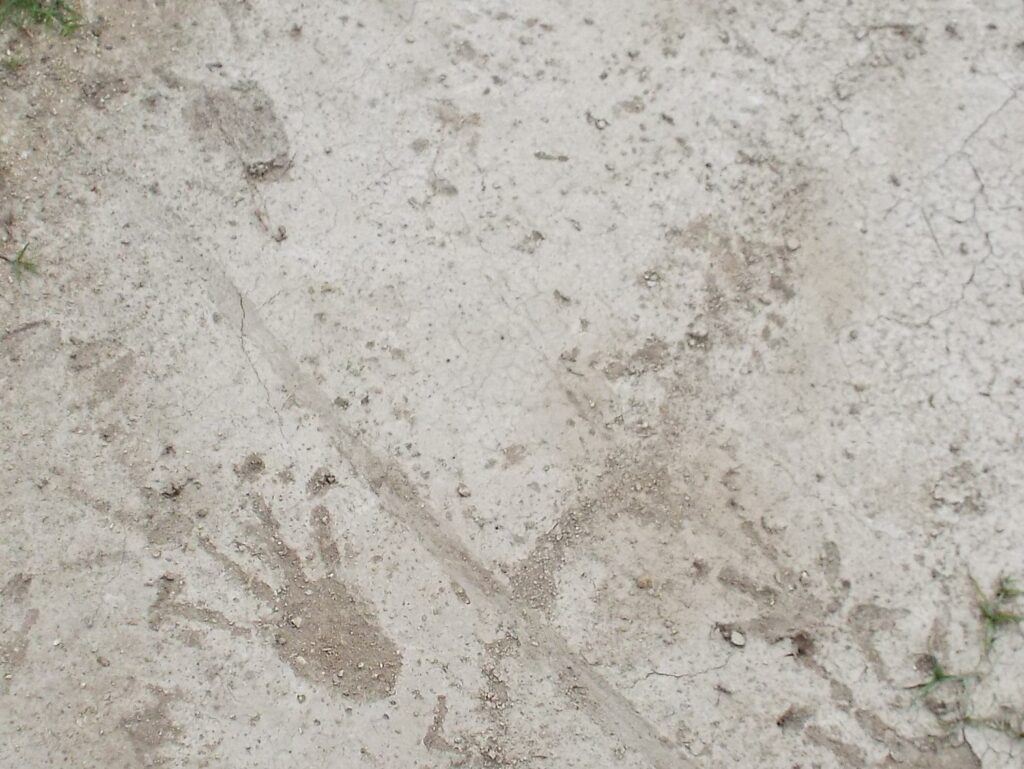
3. American Alligator
The tracks of the American Alligator are hard to mistake. Alligators produce the largest tracks of any of our wildlife. Look for handprint shaped tracks that can exceed a foot in length with long toes, claw marks, and usually accompanied by a tail drag.
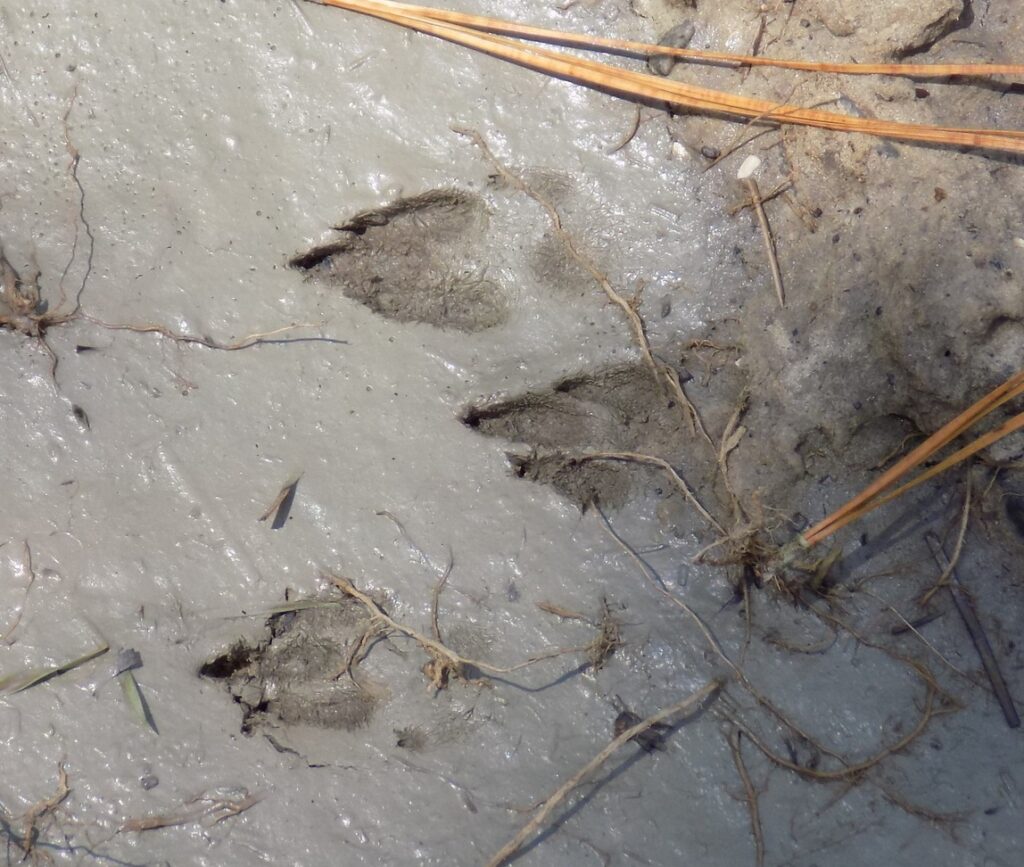
4. Marsh Rabbit
The tracks of Marsh Rabbits are basically identical to those of the Eastern Cottontail, but the latter rarely ever ventures onto marsh flats. I’ll just be talking about Rabbit tracks in general here. Rabbits have pointed, asymmetrical, 4-toed tracks. The gait of Rabbits is distinct. Their bounding movements leave all of their tracks bunched together with the front feet landing one in front of the other and their rear feet landing directly across from each other, outside of the front prints. The further forward the rear prints are in relation to the front prints, the faster the Rabbit was moving.
The most similar tracks to those of Rabbits are Squirrels but only in gait. Squirrels also travel in a bounding motion but they have 5 rear toes, symmetrical front feet, and thinner, more hand shaped prints. Squirrels never venture into the salt marsh, where Marsh Rabbits live.
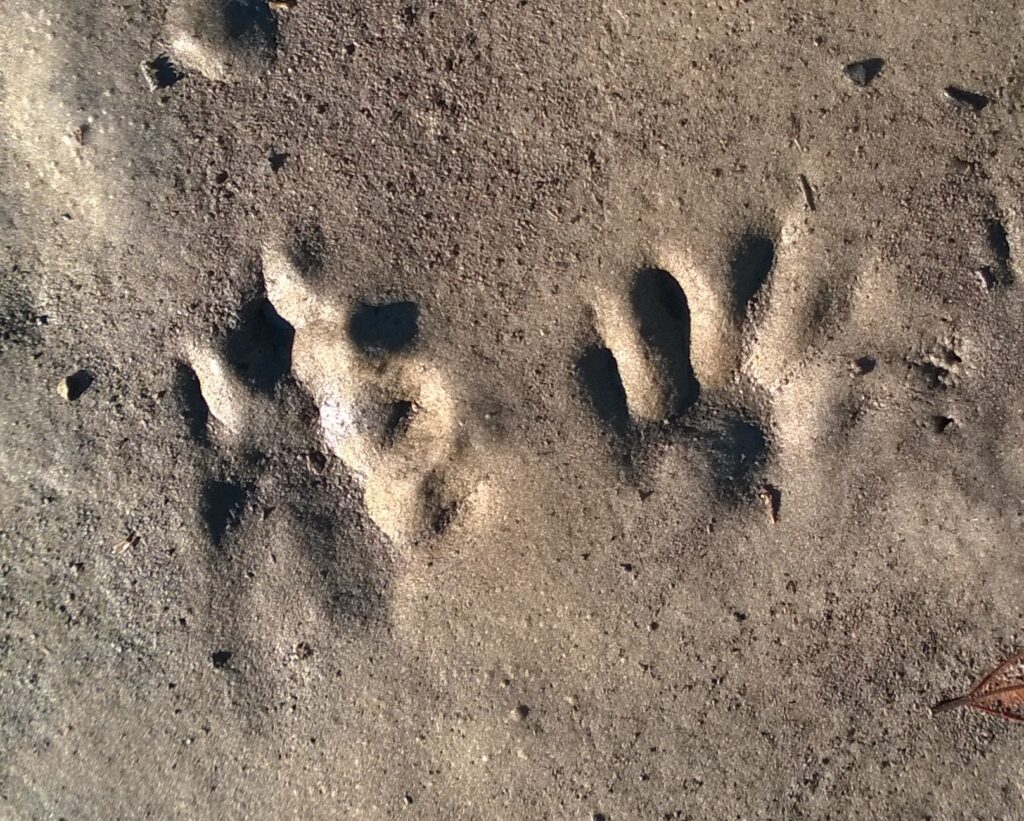
5. Common Raccoon
Raccoon tracks are incredibly common. They have 5 toes on both feet, with the rear heel being markedly larger than the front. The tracks are hand shaped with the toes having a weak claw and strong connection to the heel. Raccoons like washing their food, so look for their tracks anywhere there’s standing water, especially in pluff mud.
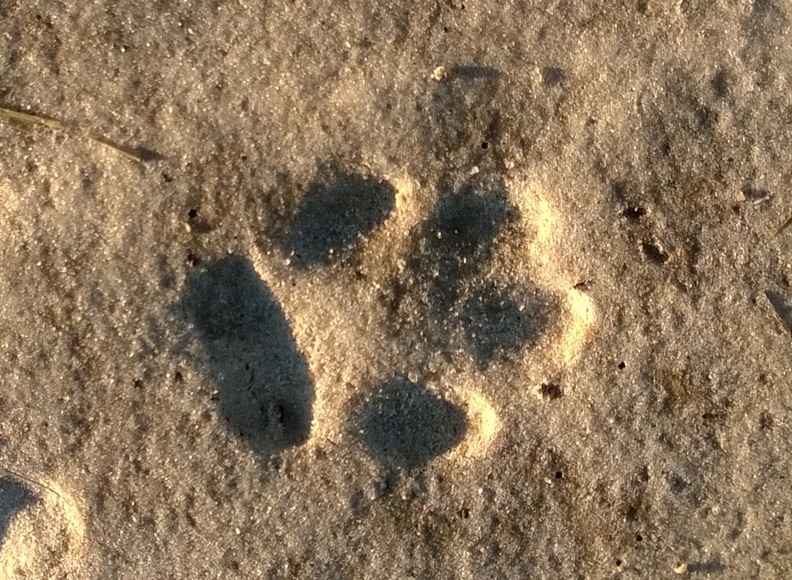
6. Coyote
Coyote tracks are symmetrical with 4 toes and distinct claw marks. They’re typically 3 to 4 inches long. Coyote tracks are very similar to those of the Domestic Dog but there are some distinctions that can help tell the two apart. Dogs, especially retrievers, have larger, wider feet. Dogs are also typically much heavier than Coyotes, who rarely exceed 40lbs. For their weight, Coyotes have large feet. This makes their tracks rather shallow, and narrow, with little claw showing. Coyote tracks are compact and oval in shape. Dogs are much bulkier, so their feet splay out and they use more claw for traction. This gives Dog tracks a circular shape and their toes spread further apart and have prominent claw marks. Foxes have similar tracks to Coyotes but the tracks are smaller in size and have a slight gap between the front and rear toes.
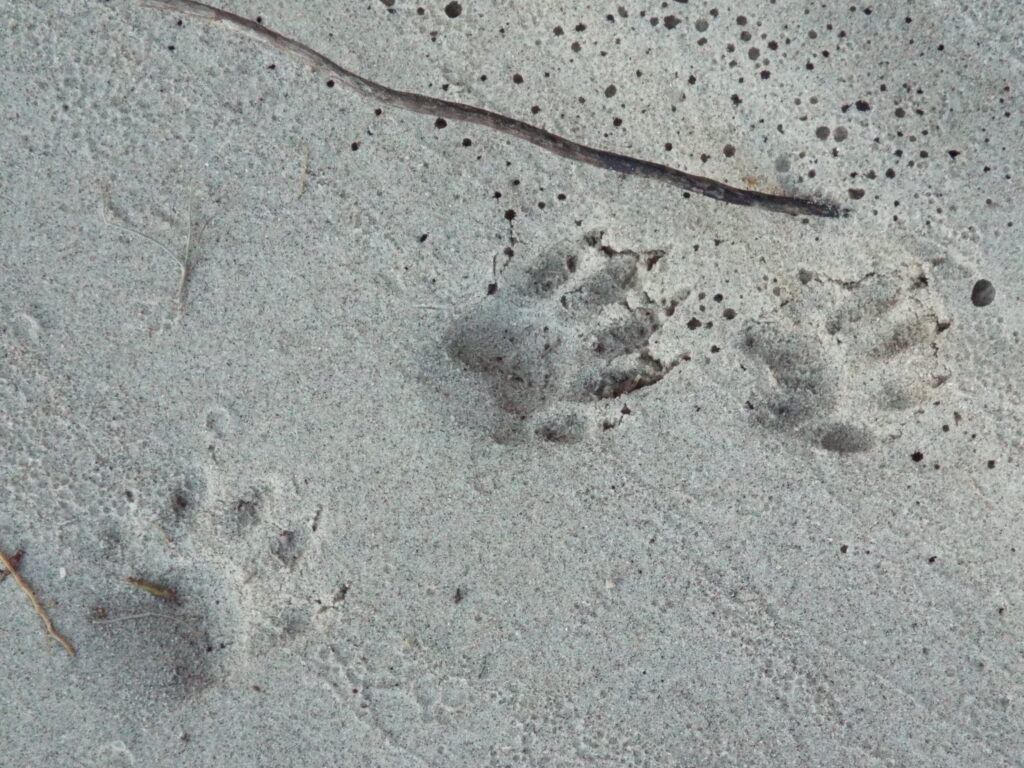
7. North American River Otter
River Otter tracks are large, have five toes, obvious claw marks, a long rear heel, and occasionally a tail drag. Otter tracks are always near water. Look for their tracks on causeways and dikes around water control structures. They resemble Mink tracks but are much larger, with front tracks up to 4 inches in length. Their chaotic, weaselly gait and playful social nature means their tracks are often a mess of several individuals bouncing and rolling around in an area.
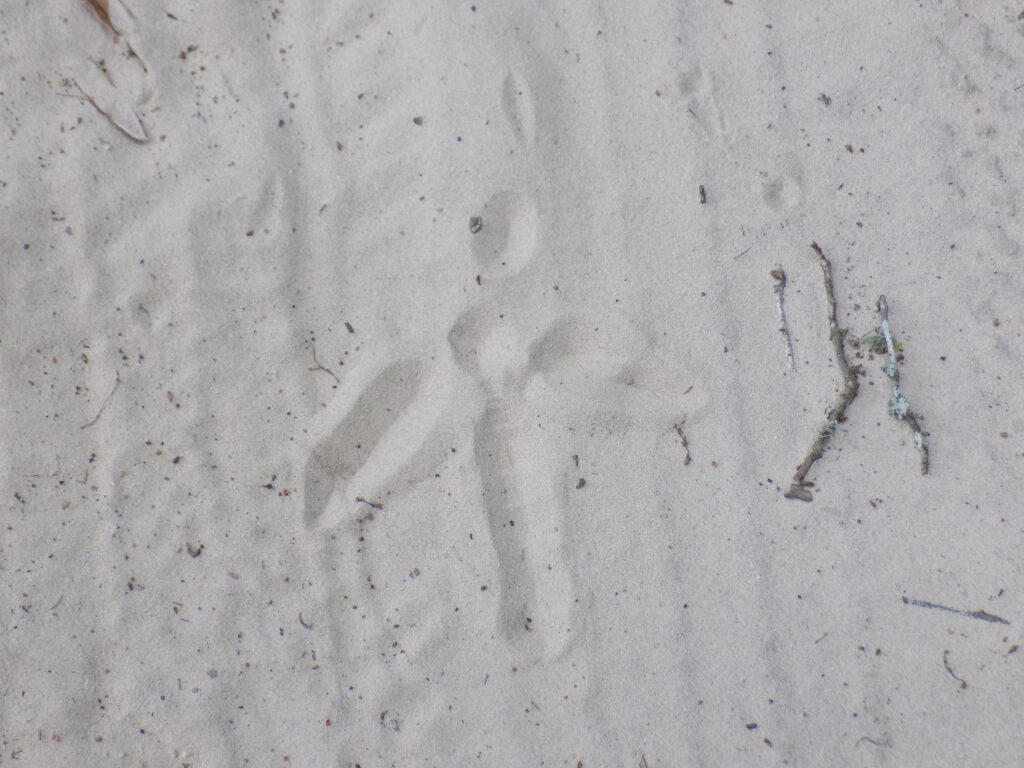
8. Wild Turkey
Turkey tracks are the one bird track you can reliably identify. They have large 3- toed tracks, a prominent heel dot, and a relatively small rear toe and claw mark. Their tracks are usually about 6 inches in length. The only other bird that commonly leaves tracks this large is the Great Blue Heron. The Turkey is significantly heavier than any Heron; this means Turkey toes are much wider. Herons have longer tracks with a prominent rear toe.
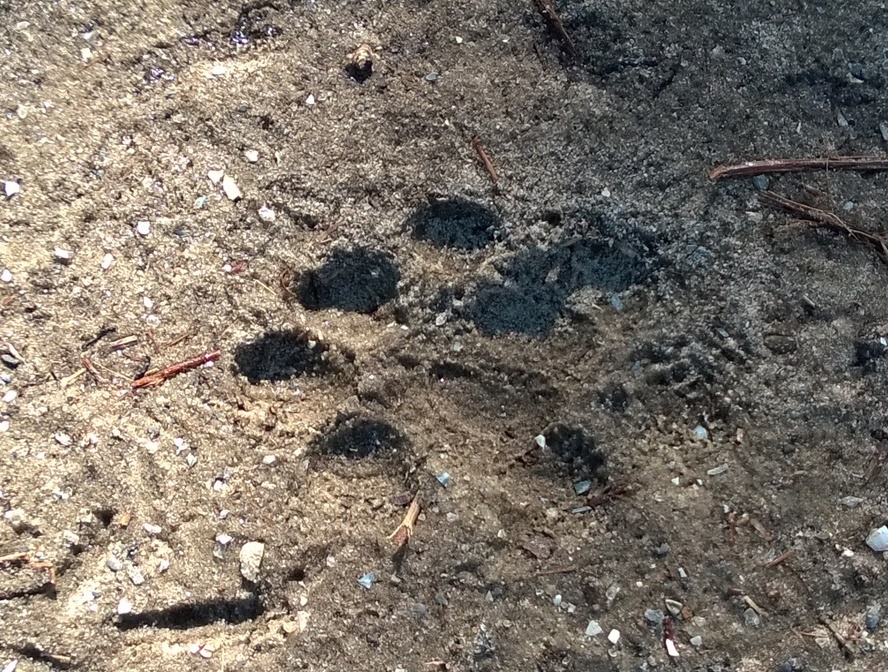
9. Bobcat
Bobcat tracks are asymmetrical with four toes and no claw marks. In the Southeast, their tracks are practically identical to those of Domestic and Feral Cats. There’s no easy way to tell the two apart but their gait can be telling. Bobcats are taller and longer than Feral Cats, so their stride is longer. Bobcats also travel longer distances in search of prey than do Feral Cats. So, if you have a good enough trail, you can make a good guess about the size of that cat and how far it went. The track above is two prints on top of each other. They came from a Bobcat who I tracked after this recent snowfall. I followed her trotting tracks for over a mile through the snow.
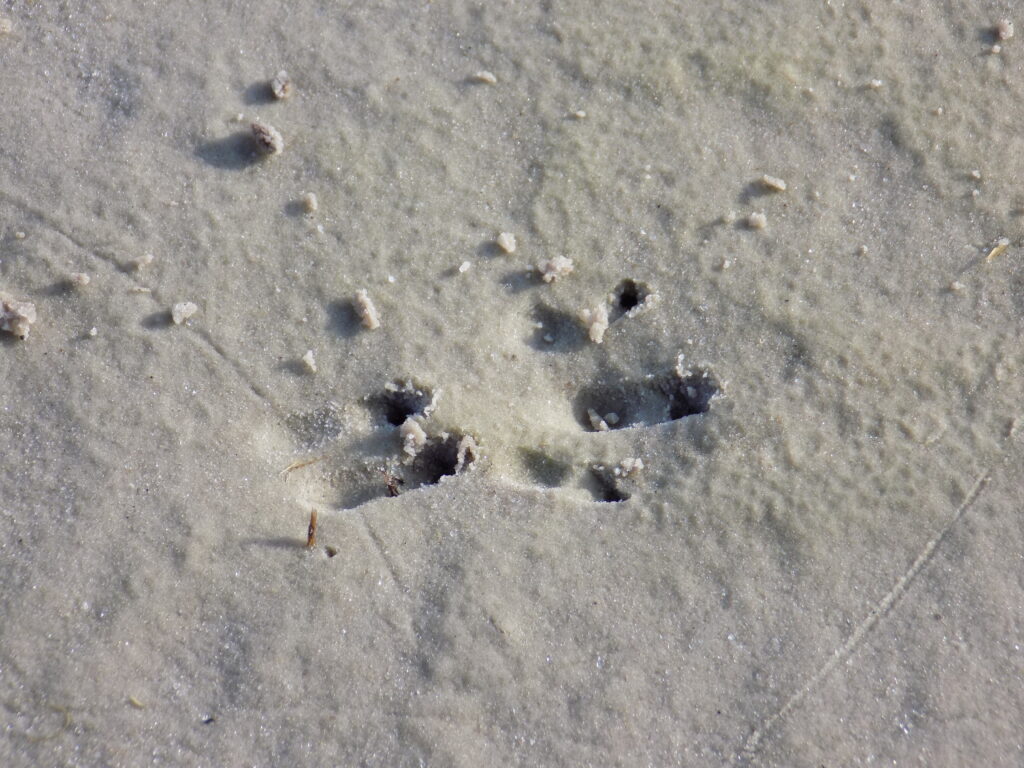
10. Nine-banded Armadillo
The Nine-banded Armadillo has a track like no other in our area. Typically, their front track is two toe/claw marks and their rear three but occasionally they have 4 and 5 respectively. Like a lot of four-legged mammals, when walking Armadillos move both legs on one side of the body at once, placing the rear foot in front of where the front foot just was. This creates a strange looking “5-toed” track, like in the picture above, with 3 toes in front and 2 in back but in reality it’s two tracks, one ahead of the other.
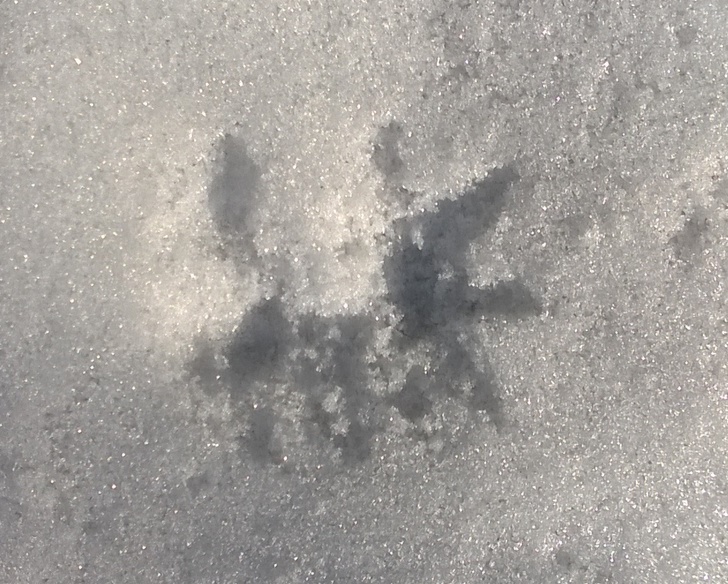
11. Virginia Opossum
The Virginia Opossum is another mammal with an unmistakable set of tracks. I rarely see their tracks but there’s no question about who made them when I do. Opossum tracks have five toes on both feet and the front and back feet are very differently shaped. The front track is shaped like a stubby, wide open handprint and the rear track like a closed hand with a thumb that points in almost the opposite direction from the fingers. The photos above are in snow, so it’s a bit difficult to make out the fingers. These wonky feet are built for climbing trees. Their wide grip allows them to easily scale trees and walk along branches.